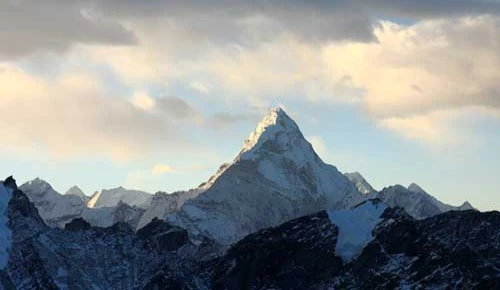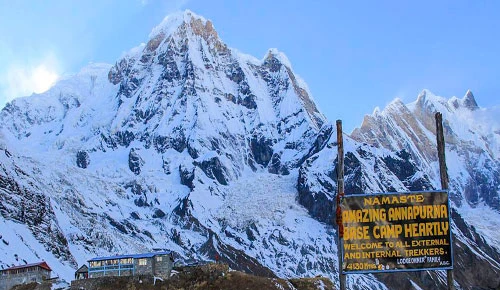Hiking Langtang: A Beginner's Guide to Difficulty & Preparation
The Langtang region of Nepal, located in the heart of the Himalayas, provides an outstanding combination of natural beauty, heritage, culture, and adventure. Langtang is located on the northern side of Kathmandu and is known for its natural scenery, high peaks, and active Sherpa, Tamang cultures and Heritage Trail. The region is named after the Langtang Valley, which serves as a gateway to Langtang National Park, one of Nepal's first and most accessible protected areas.
The Langtang Short Trek takes you on an unforgettable journey across Nepal's breathtaking scenery. Although this journey is shorter in duration than others in the area, it captures the essence of the Himalayas with its beautiful peaks, lush forests, and vibrant local culture. The Langtang Short Trek, which typically lasts 7 days, is ideal for explorers looking to experience Nepal's natural beauty and cultural legacy in a reasonable time period.

The beauty of the Himalayas is likely to be the most spiritual experience you've ever had. The breathtaking Langtang landscape of Nepal is hidden behind boundless hills and high pinnacles. Overcoming each of these peaks is another challenge you haven't encountered. Nonetheless, eventually, it's the achievement you recall. Individuals frequently change their arrangements without knowing "how difficult the Langtang Valley journey" is.
Importance of Evaluating Trek Difficulty
Evaluating the complexity of this trek is critical to ensuring a safe and pleasurable experience. Trekkers might better prepare for their expedition by recognizing the hurdles involved. Here is the importance of evaluating the trek difficulty:
- It helps trekkers prepare adequately for potential risks and challenges, reducing the likelihood of accidents or injuries.
- Allows trekkers to set realistic expectations and choose routes that align with their abilities, maximizing enjoyment and satisfaction.
- HelpsIt helps trekkers plan their training regimen, pack appropriate gear, and make informed decisions about their itinerary, accommodations, and support services.
- It helps trekkers anticipate and address potential challenges such as altitude sickness, inclement weather, or challenging terrain, minimizing unexpected setbacks.
- Encourages sustainable practices and minimizes the impact on the environment and local communities.
Table of Contents
Langtang Short Trek Difficulty
The short trek to Langtang Valley has its share of difficulties, despite being shorter in length. The short trek is considered moderately difficult to reach Langtang Valley. Trekkers should be prepared to face steep ascents and descents, rough terrain, and changing weather conditions. Furthermore, the great altitude of the Himalayas raises the risk of altitude sickness, requiring careful acclimatization and knowledge of symptoms.
However, with adequate preparation and a fair level of fitness, this short trekking to Langtang Valley is achievable for trekkers of all ages and experience levels. The pleasures of seeing the breathtaking scenery of the Langtang Valley and connecting with the local communities make the trek's difficulties worthwhile.
Factors Affecting Trek Difficulty
Trekking can be an exciting adventure, but it's important to understand the factors that influence the difficulty level of a trek, especially when planning a demanding trip like the short trek to Langtang. Here are some significant aspects influencing the difficulty of the journey:
Altitude and Elevation Gain
One of the most important aspects influencing hike difficulty is altitude. As you ascend, the air thins, resulting in reduced oxygen levels. Elevation gain is the total vertical distance climbed throughout the expedition. Steeper ascents can be physically challenging, particularly for people who have never been to high altitudes. Altitude-related problems such as altitude sickness, shortness of breath, and fatigue can considerably increase the difficulty of a trek.
Trail Conditions and Terrain
The complexity of the journey route is greatly affected by the trail's condition and the terrain encountered along the way. Rough, uneven terrain with steep inclines or descents requires greater physical effort and concentration. Loose rocks, gravel, dirt, snow, and ice can make the trail slippery, increasing the danger of an accident or injury.

Weather and climate
Weather conditions can vary quickly in mountainous areas, affecting the difficulty of the hike. Rain, snow, wind, and high temperatures can all add to the difficulty and danger of the trek. Trekkers must be prepared for severe weather and have the necessary equipment and clothing to stay safe and comfortable.
Length & Duration
The length and duration of this trek also affect its difficulty level. Longer journeys need more physical endurance and mental resilience to maintain energy levels over an extended period of time. Trekking for several days or weeks requires carrying heavier backpacks containing critical supplies, which adds to the physical strain.
Personal Fitness and Experience Levels
Personal fitness and prior trekking experience play an important role in determining the difficulty of a trek. Trekkers with higher fitness levels and expertise hiking at high elevations may find the trek less difficult than those who are less fit or inexperienced. To reduce the chance of injury or tiredness, trekkers must honestly analyze their fitness levels and choose a journey that is appropriate for them.
Understanding these factors and their impact on trip difficulties will help trekkers prepare properly and make informed decisions while planning their journey in the Langtang region or any other challenging environment.
Preparation Required for Langtang Valley
Some warm-up before the climb assists you with defeating the Langtang journey trouble. A couple of months before the trip (2 to 3 months), you can begin journeying to a few spots around your area. You could rehearse ordinary running, cycling, and swimming. Participating in cardio exercises is useful. If you are ready with such commitment, the Langtang Valley journey is not too difficult to trek.
Physical Fitness
You don’t need to bother to be an accomplished traveller; great well-being is necessary. Assuming you have heart and lung issues, we don't recommend you go on this trek. Anyone under medication shouldn't attempt the Langtang Valley trek without the doctor's authorization. Regardless of whether you have any such medical problems, you should prepare your body for the exercise.
Altitude Sickness
To start with, you ought not to be walking more than 1000 meters every day. Thus, at whatever point you pick a Langtang hike schedule, pick the one that includes a short climb every day. Walking slowly and allowing your body to adapt is the key.

Then, you should stay hydrated all through the trip. We strongly suggest that you avoid drinking at higher altitudes. If you notice any of the side effects, you can embrace these precautions:
- Immediately inform your guide about your condition
- Take medication for the pain in the body and head
- Avoid climbing any further
- After some rest, slowly walk down to the lower altitude
- In the worst case, ask for a helicopter for rescue
Tips for Short Trip to Langtang Valley
- Begin your fitness regimen at least a few months before your trek. Focus on cardiovascular exercises like hiking, cycling, and jogging to improve endurance.
- Incorporate strength exercises targeting legs, core, and upper body to build overall strength. Squats, lunges, and planks are beneficial.
- Gradually increase the intensity and duration of your hikes, simulating the conditions you'll encounter during the Langtang Short Trek.
- If possible, train at higher altitudes or use altitude training masks to prepare your body for the reduced oxygen levels at higher elevations.
- Plan your itinerary with gradual altitude gains to allow your body time to acclimatize properly. Avoid rapid ascents that increase the risk of altitude sickness.
- Drink plenty of water to stay hydrated, as dehydration can worsen altitude sickness symptoms. Aim for 3-4 liters of water per day.
- Be vigilant for symptoms of altitude sickness, such as headaches, nausea, dizziness, and fatigue. Descend immediately if symptoms worsen.
- Dress in layers to adjust to changing weather conditions. Bring moisture-wicking base layers, insulating mid-layers, and waterproof outer layers. Don't forget a hat, gloves, and sunglasses.
- Invest in sturdy, broken-in hiking boots with ankle support and good traction. Carry extra socks to keep your feet dry and comfortable.
- Choose a comfortable, well-fitting backpack with padded straps and a waist belt to distribute weight evenly. Opt for a size that can accommodate your essentials without being overly bulky.
- Carry a first aid kit, including medications for altitude sickness, blister care, pain relief, and any personal prescriptions. Don't forget sunscreen, lip balm with SPF, insect repellent, and a headlamp or flashlight with extra batteries.
- Consider hiring a local guide or joining a group tour for added safety and convenience, especially if you're unfamiliar with the terrain or traveling solo.
Travel Insurance
Travel insurance is important for all trekkers in high-risk areas or while on an adventure tour. Langtang falls in Nepal's remote Himalayan region, with limited vehicle accessibility and barely any health posts on the trail. Furthermore, due to Langtang Valley Trek’s high altitude, which crosses more than 4,500 m or 14,763ft of altitude, it is difficult to get proper and prompt treatment in case of any unfortunate incidents or illnesses.
Due to such reasons, it is vital to get travel insurance for this trek. For proper insurance, look for an insurance company and plan that address insurance coverage against high-altitude treks up to 5000 meters and a cancellation policy. For that, make the insurance company aware of your region of travel, day-to-day itinerary, and maximum altitude for the trek.
Packing Essentials
This 7 days Langtang trek takes you to a height above 5000 meters; consequently, the weather conditions are regularly colder on those peaks. During the beginning of spring and the end of the fall season, the temperature gets colder, and in winter it even dips below zero degrees. During these months, it is important to wear hotter garments, strong shoes, and journeying shafts. As this is a tea house journey, you won't need to set up camp stuff like a hiking bed, tents, etc. Besides, it is a moderate trip, so you won't need gear like gaiters and crampons.
If you are not taking a porter along on the trek and are conveying the backpack on your own, then make sure to pack light essentials, take just the basics, and leave other superfluous things in Kathmandu. If you are going on an agency package, you can likewise talk with the team or guide and be more straightforward, as a doorman will convey your weighty baggage.
Hiring a Guide
You need to contact the local guides, who will assist you in setting up your trip. While travelling with a guide and porter, you will have to manage their accommodation, food, land travel, tips, insurance, and fees. It's a better option to go on a trek with a guide because they know the local language and have trekking experience in the area, and porters will also carry the luggage for you, making your trek easier and simpler.
Journey To Langtang Valley
At the point when you pick a very oversaw Langtang journey bundle from a trusted company like Nepal Trek Adventure and Expedition, everything about the trip will be conveniently organized. Having an accomplished and experienced guide on the trek saves you from numerous unseen challenges. Likewise, a doorman will convey your bags, and you can walk freely. Accommodation, facilities, medical aid, and every other detail will be taken care of.
In short, the Langtang Valley journey is not a tricky travel trail. Anyone who is physically fit and has no experience with high trips can undoubtedly come to Kyanjin Gompa and back. However, you will require proper direction and help from the guide to conquer the Langtang journey. What else do you want to be aware of? Our expert team will readily help you with Langtang journey planning.








